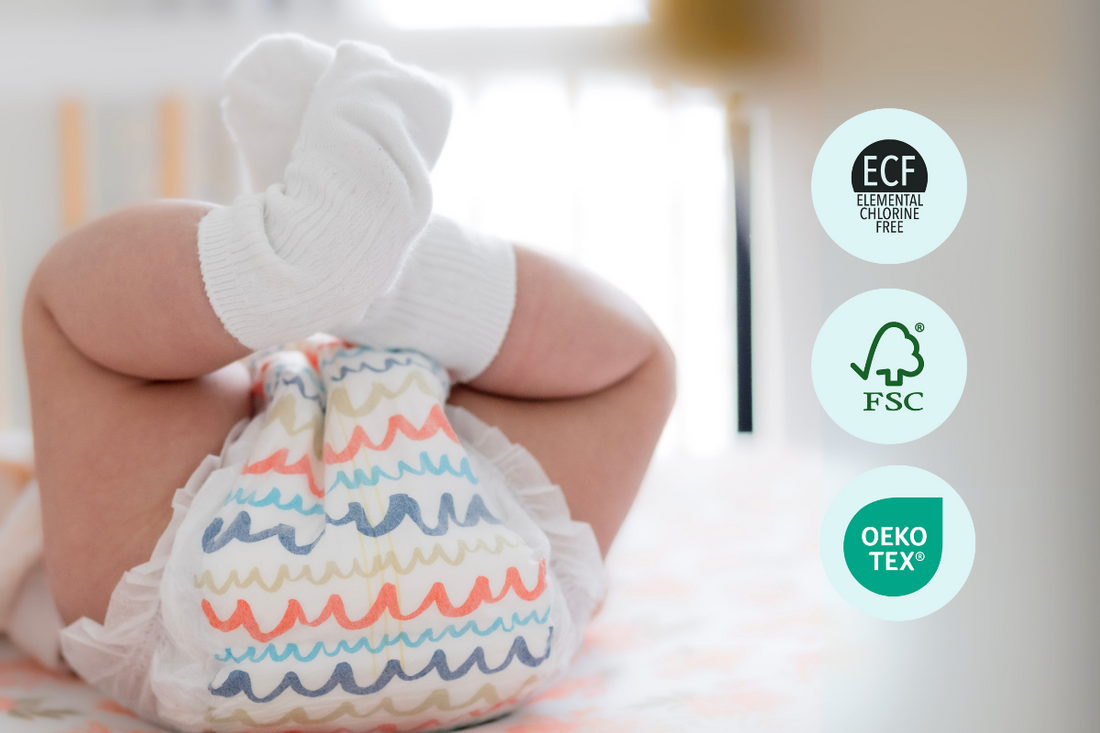If you’ve been searching for the “cleanest” and “safest” diapers for your baby, you’ve probably come across the terms TCF (Totally Chlorine Free) and ECF (Elemental Chlorine Free). And if you’ve also found yourself confused… you’re not alone.
There’s a lot of conflicting information online—especially on blogs and social media—that can make this topic seem more alarming than it really is. Let’s break it down with real science (not internet rumors), so you can make an informed decision.
First, why does chlorine even come up in diaper talk?
Diaper cores are made from wood pulp. In the past, pulp was bleached with Elemental Chlorine, a process that released dioxins—toxic compounds that harmed the environment around pulp mills.
In the 1990s, the EPA put new rules in place to protect the environment. The industry switched to ECF processing, which replaced Elemental Chlorine with Chlorine Dioxide.
And here’s the important part:
- Chlorine Dioxide ≠ Dioxins
- The modern ECF process is safe, clean, and does not create the harmful byproducts that were once a concern.
So what’s the difference between TCF and ECF?
-
ECF (Elemental Chlorine Free): Uses chlorine dioxide to bleach the pulp. This process eliminates the old dioxin problem, is highly efficient, and uses less energy and wood.
-
TCF (Totally Chlorine Free): Uses no chlorine compounds at all—bleaching pulp instead with hydrogen peroxide, oxygen, or ozone.
Both methods are safe for your baby. The differences are really about environmental impact and manufacturing efficiency, not health or safety.
Why isn’t everyone using TCF?
When TCF technology was introduced in Sweden in the 1990s, it seemed like the future. But over time, industry experts realized:
- TCF uses more energy to produce.
- It requires more wood to get the same amount of pulp (meaning more trees harvested).
- This higher energy and resource use cancels out many of its environmental benefits.
That’s why only around 4% of the world’s pulp production today uses TCF. Even in Sweden—where it was invented—new pulp mills are built using ECF because it has proven to be just as safe and more sustainable in the long run.
The takeaway: both are safe, but ECF is the better environmental choice
When it comes to your baby’s health, there’s no difference—pulp processed with either method is totally safe and chlorine-free. The choice comes down to environmental priorities.
At Kiddicare, we believe that preserving forests and reducing energy usage is critical for the future our children will grow up in. That’s why our diapers are made with American-made ECF pulp from FSC-certified, sustainably managed forests.
We’ve had our diapers independently tested to confirm they’re free from chlorine, phthalates, fragrances, latex, parabens, and bleach. And because baby skin is up to 5x thinner than adult skin, we make sure our diapers are gentle, safe, and effective—without compromise.
Bottom line: Don’t let the internet noise scare you. Modern ECF and TCF pulp are both safe, but we choose ECF for its balance of safety, sustainability, and efficiency—because protecting your baby’s future means protecting the planet they’ll live on.
If you want to see the difference for yourself, check out our Kiddicare Starter Bundle.

